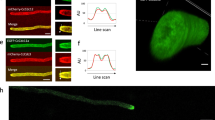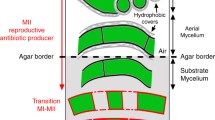Summary
Growing hyphal tips of higher fungi contain an organized assemblage of secretory vesicles and other cell components collectively known as the Spitzenkörper. Until now, the Spitzenkörper has been portrayed as a single spheroid complex located near the apical cell wall. This study demonstrates the occurrence of multiple Spitzenkörper in growing hyphal apices imaged by video-enhanced phase-contrast microscopy. In addition to the main Spitzenkörper, smaller satellite Spitzenkörper arise a few micrometers behind the apical pole. Four developmental stages were identified: (a) the satellites first appeared as faint phase-dark plaques next to the plasma membrane, (b) gradually increased in size and assumed an ovoid profile, (c) they migrated to the hyphal apex, and (d) finally they merged with the main Spitzenkörper. After the merger, the main Spitzenkörper temporarily increased in size. Satellites were observed in 14 fungi, most of which had relatively large (5–10 μm diam.), fast-growing hyphae (2–33 μm/min elongation rate). The average frequency of in-focus satellites was 7+/min forFusarium culmorum and 11+/min forTrichoderma viride. As with the main Spitzenkörper, satellites were present only in growing cells. They were transient and remained visible for 3–8 s before merging with the main Spitzenkörper. Within the hyphae, satellites travelled up to six times faster than the average cell elongation rate. Multiple satellites sometimes occurred simultaneously; up to three were seen within a hyphal apex at the same time. Localized cell enlargement occurred next to stationary satellites, suggesting that satellite Spitzenkörper are functional as sources of new cell surface before they reach the main Spitzenkörper; therefore, they account for some variations in the profiles of the growing hyphae. By electron microscopy, satellites consisted of small clusters of apical vesicles surrounding a group of microvesicles located next to the plasma membrane. The identification and behavior of the satellites represent clear evidence of directional mass transport of vesicles toward the hyphal apex. Our observations indicate that satellites are a common phenomenon in growing hyphal apices of septate fungi and that they contribute to growth of the hyphal apex.
Similar content being viewed by others
Abbreviations
- VSC:
-
vesicle supply center
References
Bartnicki-Garcia S (1990) Role of vesicles in apical growth and a new mathematical model of hyphal morphogenesis. In: Heath IB (ed) Tip growth in plant and fungal cells. Academic Press, San Diego, pp 211–232
—, Hergert F, Gierz G (1989) Computer simulation of morphogenesis and the mathematical basis for hyphal (tip) growth. Protoplasma 153: 46–57
— — — (1990) A novel computer model for generating cell shape: applications to fungal morphology. In: Kuhn PJ, Trinci APJ, Jung JJ, Goosey MW, Copping LG (eds) Biochemistry of cell walls and membranes in fungi. Springer, Berlin Heidelberg New York Tokyo, pp 43–60
Bourett TM, Howard RJ (1991) Ultrastructural immunolocalization of actin in a fungus. Protoplasma 163: 199–202
Brunswik H (1924) Untersuchungen über Geschlechts- und Kernverhältnisse bei der HymenomyzetengattungCoprinus. In: Goebel K (ed) Botanische Abhandlung. Gustav Fischer, Jena, pp 1–152
Girbardt M (1957) Der Spitzenkörper vonPolysticus versicolor. Planta 50: 47–59
— (1969) Die Ultrastruktur der Apikalregion von Pilzhyphen. Protoplasma 67: 413–441
Grove SN (1978) The cytology of hyphal tip growth. In: Smith JE, Berry DR (eds) The filamentous fungi, vol 3. Wiley, New York, pp 559–592
—, Bracker CE (1970) Protoplasmic organization of hyphal tips among fungi: vesicles and Spitzenkörper. J Bacteriol 104: 989–1009
— —, Morre DJ (1979) An ultrastructural basis for hyphal tip growth inPythium ultimum. Amer J Bot 57: 245–266
Heath IB (1990) The roles of actin in tip growth of fungi. Int Rev Cytol 123: 95–127
—, Kaminskyj SGW (1989) The organization of tip-growth-related organelles and microtubules revealed by quantitative analysis of freeze-substituted oomycete hyphae. J Cell Sci 93: 41–52
—, Rethoret K, Arsenault AL, Ottensmeyer FP (1985) Improved preservation of the form and contents of wall vesicles and the Golgi apparatus in freeze substituted hyphae ofSaprolegnia. Protoplasma 128: 81–93
Hoch HC (1986) Freeze substitution of fungi. In: Aldrich HC, Todd J (eds) Ultrastructure techniques for microorganisms. Plenum, New York, pp 183–212
—, Howard RJ (1980) Ultrastructure of freeze-substituted hyphae of the basidiomyceteLaetisaria arvalis. Protoplasma 103: 281–297
—, Staples RC (1983) Visualization of actin in situ by rhodamineconjugated phalloin in the fungusUromyces phaseoli. Eur J Cell Biol 32: 52–58
Howard RJ (1981) Ultrastructural analysis of hyphal tip cell growth in fungi: Spitzenkörper, cytoskeleton and endomembranes after freeze substitution. J Cell Sci 48: 89–103
— (1983) Cytoplasmic transport in hyphae ofGilbertella. Mycol Newslett 34: 24 (Videotape, El duPont Co)
—, Aist JR (1979) Hyphal tip cell ultrastructure of the fungusFusarium: improved preservation by freeze substitution. J Ultrastruct Res 66: 224–234
— — (1980) Cytoplasmic microtubules and fungal morphogenesis: ultrastuctural effects of methyl benzimidazole-2-ylcarbamate determined by freeze substitution of hyphal tip cells. J Cell Biol 87: 55–64
—, O'Donnell KL (1987) Freeze substitution of fungi for cytological analysis. Exp Mycol 11: 250–269
Inoué S (1986) Videomicroscopy. Plenum, New York
Lancelle SA, Cresti M, Hepler PK (1987) Ultrastucture of the cytoskeleton in freeze-substituted pollen tubes ofNicotiana alata. Protoplasma 140: 141–150
Löpez-Franco R (1992) Organization and dynamics of the Spitzenkörper in growing hyphal tips. PhD Dissertation, Purdue University, West Lafayette, IN, USA
—, Bartnicki-Garcia S, Bracker CE (1994) Pulsed growth in fungal hyphal tips. Proc Natl Acad Sci USA 91: 12228–12232
McKerracher LJ, Heath IB (1987) Cytoplasmic migration and intracellular organelle movements during tip growth of fungal hyphae. Exp Mycol 11: 79–100
McClure WK, Park D, Robinson PM (1968) Apical organization in the somatic hyphae of fungi. J Gen Microbiol 50: 177–182
Raudaskoski M, Salo V, Nhni SS (1988) Structure and function of the cytoskeleton in filamentous fungi. Karstenia 28: 49–60
Roberson RW (1992) The actin cytoskeleton in hyphal cells ofSclerotium rolfsii. Mycologia 84: 41–51
—, Fuller MS (1988) Ultrastructural aspects of the hyphal tip ofSclerotium rolfsii preserved by freeze substitution. Protoplasma 146: 143–149
Runeberg P, Raudaskoski M (1986) Cytoskeletal elements in the hyphae of the homobasidiomyceteSchizophyllum commune visualized with indirect immunofluorescence and NBD-phallacidin. Eur J Cell Biol 41: 25–32
Author information
Authors and Affiliations
Rights and permissions
About this article
Cite this article
López-Franco, R., Howard, R.J. & Bracker, C.E. Satellite Spitzenkörper in growing hyphal tips. Protoplasma 188, 85–103 (1995). https://doi.org/10.1007/BF01276799
Received:
Accepted:
Issue Date:
DOI: https://doi.org/10.1007/BF01276799




